Some images can be seen at a bigger size on paintedstork facebook page
As monsoon clouds move into the western ghats in the early days of June, the hills of Chikmagalur see a remarkable transformation. The vistas of grassy slopes and the dense forests of Bhadra Wilderness disapper under a blanket of thick fog. The fog never recedes for the next three months and it looks as if the skies have disappeared, never to come back again. But come September, it goes away as magically as it had arrived to reveal the beautiful blue skies and to welcome the warmth of the sun.
Chandradrona Parvata, commonly known as the hills of Bababudangiri Hills, host the highest peaks in Karnataka and is home to some of the densest rainforests in the region. I made a dashing visit to the hills this monsoon season and made an attempt to capture the foggy hillscapes. Here is a collection of images of Chandradrona’s Fog.
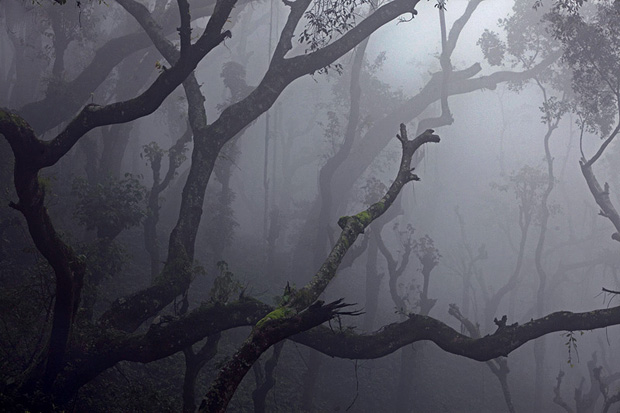
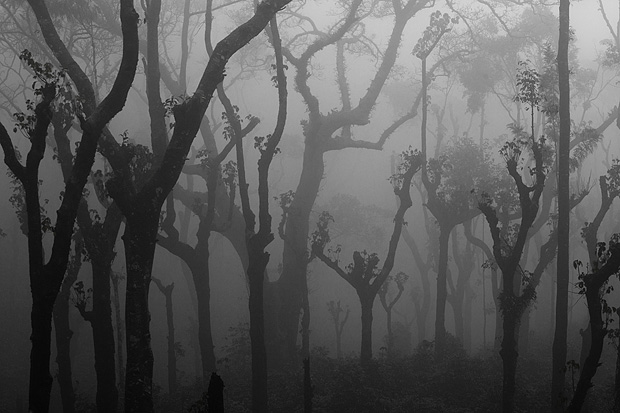
Coffee estates dominate the slopes of Bababudangiri. The district of Chikmagalur, along with neighbouring Coorg, grows bulk of the coffee produced in India. The need for a balance of sun and shade in coffee estates allows coffee growers to retain some of the trees that naturally grow in the region, but they constantly chop the branches and leaves to allow some sunshine to seep in. This creates a weird landscapes full of tall trees standing bare, often with only tender leaves sprouting from their hacked branches. Add a foggy monsoons that hides the details in the landscape and you get an eerie atmosphere in the hills.
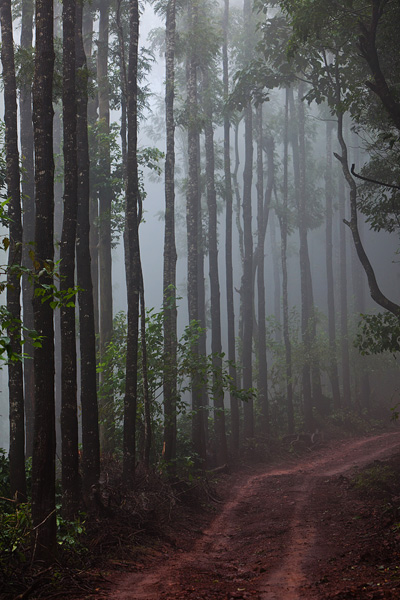
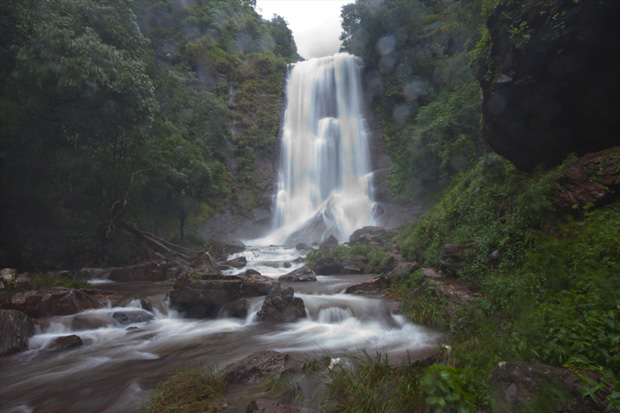
Many roads in the hills are without tarmac and sometimes you can barely call them roads. Many roads are also privately owned by the coffee estates that are spread over thousands of acres. We drove through one such road on an ancient Mahindra that lacked the luxuries of shock absorption. Sometimes we treaded over rocks when the road disappeared in stretches, each time double checking to ensure that our backs have stayed unbroken. The road lead to the roaring Hebbe Falls that was falling with full force in the peak monsoon season. I stood in the narrow valley of the stream and felt the wrath of the waterfall whose sprinkles made me completely wet in a matter of seconds. I went there determined to take a picture and decided not to step back despite being faced by a jet of droplets hurled away from the waterfall into me. Keeping the camera covered most of the time, I set it up on a tripod, composed blindly and hurriedly took a picture, exposing the camera in the open just for a few seconds. The lens surface became completely wet in those few seconds and you can see the droplets in the picture. I knew this was a task meant to fail, but I had no heart to come back without trying.
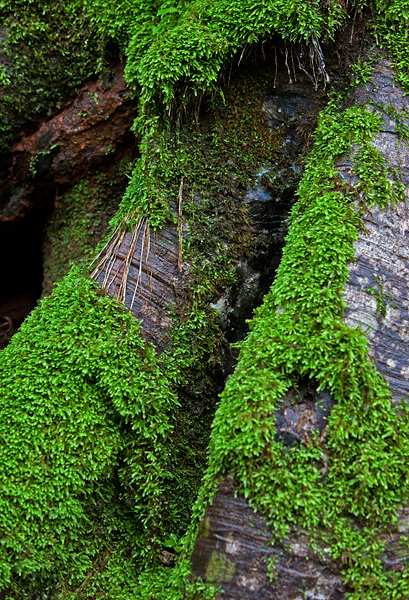
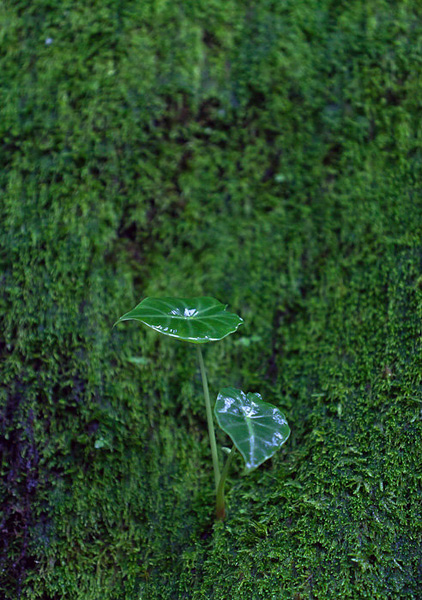
Monsoon is the season of fertility in the highlands of Chandradrona. Every exposed surface remains wet all through the three months of rain. Life in different shape, form and size grows effortlessly at the slightest opportunity; even tree trunks are never spared.
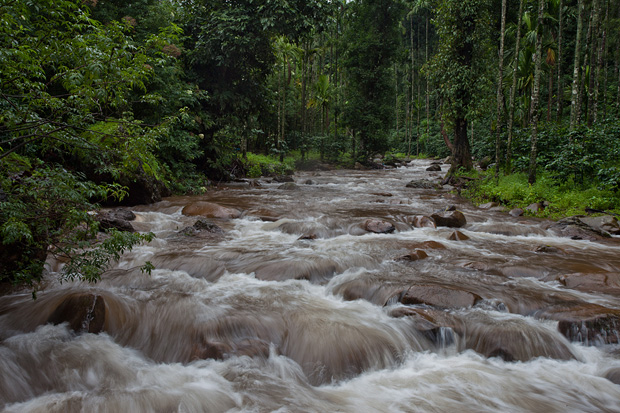
Innumerable streams crisscross the forests in these mountain, sometimes rushing down the hills in a great hurry and sometimes meandering gently through the forests. They come together in River Bhadra and feed the plains of the Indian peninsula. These streams come alive during the monsoons, charged by the continuous rains that keeps pouring throughout these three months.
Prints of all the images available. Request for prints.
I spent the September busy, if not pretending to be busy. To tell you the truth, all I did was to travel and muse about travel. A trip to Shimla kept me in in a mood for mountains for a long time, when all I did was to let my thoughts linger there. As they often say these days, I needed another holiday to get over the holiday mood.
This time the destination was the hills of Mullayyanagiri bordering the Bhadra Wildlife Sanctuary. It was going to be an inactive holiday – no intensive travel, no exploring, no photography. No activity, that’s all!
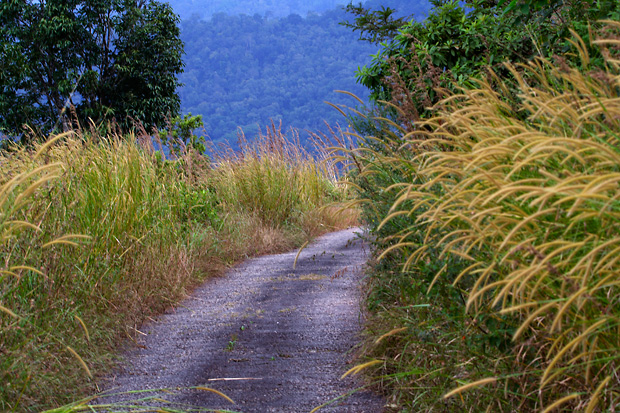
A file photo of a road near Mullayyanagiri
We had left Bangalore on a rainy afternoon and arrived at Chikmagalur at 11pm – a little later than we would have liked to. It was still drizzling as we got into the rugged jeep that took us deeper into the hills. We drove on a wet and misty road towards the hills of Mullayyanagiri with no thoughts in the mind but to quickly reach the destination and retire for the day. I would have liked it if we were on this road during the day, when one could see the lush grass on the slopes, and when weather permits, rolling hills or the plains of Chikmagalur. But not to feel bad, we were to spend two days in a coffee estate nestled in the depth of these hills.
With us in the jeep was Prasad, the cheerful driver and the estate manager Cariappa. Cariappa kept to himself first but quickly got talking when Prasad started a conversation.
‘I have been managing the plantations here for 33 years now. There are multiple estates spread in different locations around Chikmagalur…
‘I am from Ammathi at Coorg. I would like to go back to Coorg now but they would not let me..’
‘We always used to spot some or the other wild animals on the way to the estate. There was nothing today, not even a deer or boar..’
We reached the estate exactly at midnight. Having arrived in the dark, I had no clue about the location and setting of the estate. It wasn’t much different next morning either, when I woke up to see a thick fog blocking my views. But with whatever little I could see through the fog once in a while, it did seem like a beautiful place. Occasional holes in the blanket of moving fog revealed me a hill covered with thick tropical vegetation at its base and a silver-oak plantation near its grassy ridge. It seemed like there was a valley far below hidden in the fog that I would never get to see in the days I was to spend there.
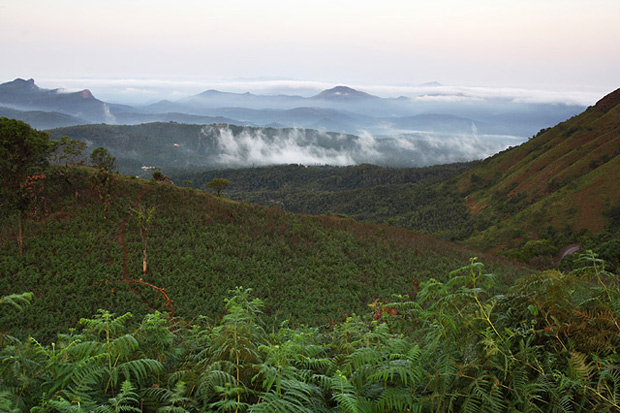
A file photo of hills near Mullayyanagiri
Within my views were the coffee plants spread on the slopes, a few buildings within the coffee estate and the dirt roads that crisscrossed the area. A silhouette of tall Silver Oaks stood parallel to each other in the fog. The trees in the estate looked wet, fresh and green, washed by three months of monsoons. The place looked mysteriously beautiful in the foggy weather, but left me in anticipation of seeing the landscape behind the depth of the fog.
Sitting back on my chair in the balcony with a book in my hand that morning, I watched the wind carry the clouds away and bringing in a fresh lot every now and then. The day was just unfolding for me, and also for the birds in the forest. I excitedly watched a barbet land on a tree very close to where I sat. A grey wagtail came closer and landed on the roof before it saw me and flew away. Malabar Parakeets made long distance flights between gaps in the canopy, squeaking loudly in flight. Red Whiskered Bulbuls inspected the nearby bushes, probably in search of worms. I watched them all, drowning cup after cup of hot filter coffee that compensated for the cold mountain breeze, occasionally glancing at my book when the outside world fell silent.
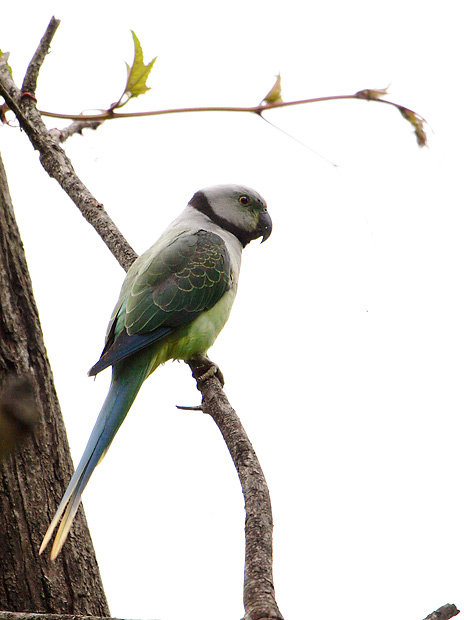
File photo of a Malabar Parakeet in Bhadra Wilderness
On a long walk past the estate later in the day, the magic of the monsoon unfolded in the slopes of the coffee country. I saw along my way, a bell-shaped purple flower with tiny water droplets on its petals that kept it fresh and beautiful. As I bent down to take a closer look, a tiny insect walked out from the heart of the flower, having had a stomach full of nectar. I peeped in closer to see two more of its kins busy feeding. A little later, I found a bee-like insect hovering over small yellow flowers, sucking the juice with ease with its long and sharp suction pipe located on its nose, which allowed it to easily delve deeper into the flower. Big butterflies of all colours hovered on the blooming flowers – one with a greenish wing with a strip of bright white, another with dark wings with a sparkling blue patch and another one bight yellow.
Up on the trees with their barks crowded with lichens, birds fluttered and sang happily. I saw a scarlet minivet that stood out in the greenery with its crimson plumage, a bunch of babblers, a flock of white-eyes and a large number of bulbuls. A hawk cuckoo sat graciously on a branch and inspected its surroundings. On a sharp curve along a steep slope where the trees were spread thinly to keep the coffee in shade, the mid-day symphony of the cicadas amplified into an almost ear-piercing clamour. Streams emerged from the slopes, appearing pristine but probably laden with pesticides from the coffee plantations sprayed before the monsoons. Fog disappeared slowly with progress of the day, revealing smooth grass laden slopes above the treeline.
A let up in the fog reveled the valley of Bhadra later in the day. In the view was thick uninterrupted greenery covered the wide basin of the valley, with hills rising again at the far end. Reflection from the waters of Bhadra Reservoir sparkled brightly near the horizon. Fog played with the scenery like a curtain raising and falling, sometimes letting in just a glimpse of the wide expanse of the vista.
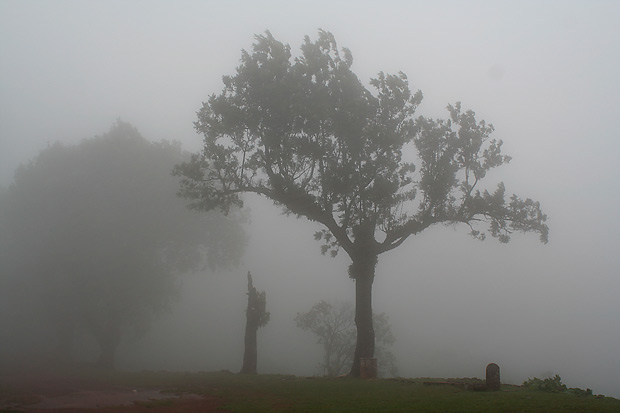
File photo – A foggy day near Mullayyanagiri
Later in the day, I spoke to Aravaind, the estate owner and former forest ranger, about the conservation efforts in Bhadra Wildlife Sanctuary. The reserve makes a good examples of rehabilitating people who once lived in the park and depended partially on the forest for livelihood. When the sanctuary was notified, the villagers in the forest were efficiently rehabilitated and every family was given arable land elsewhere in the district.
‘Some villages were deep in the forest. They had to walk for two hours to get to the nearest shop,’ Aravind told me, ‘so if they want to have some chicken for dinner, it would have been easy to go search for some fowl in the jungle than walk for four long hours.’
I have seen some results of the rehabilitation myself. In places where they had paddy fields before people moved out, you now see a bunch of bisons carelessly feasting on wild grass. Spread across an area of nearly 2,000 km², Bhadra is a tiger reserve with thick tropical forest and a population of more than 30 tigers (according 1997 census. See project tiger website). The trees here are tall and the canopy so thick, once traversing in this forest, I heard bird calls all along the way from the treetop, but never once managing to spot the origin of these sounds.
Spending another day in the foggy but pleasing weather, we drove back to Chikmagalur next day, again in darkness, again wishing that we had driven during the day.
+ Also: More monsoon journeys on India Travel Blog.
Every year, monsoon rains rock India in the month of June and stay on till September. This is the only time of the year when it rains and provides a much-desired relief from the heat for everyone. These monsoon rains are also the primary source of water for all purposes – drinking water, irrigation, industrial use and anything else. Along with being a lifeline, it is also a romanticized phenomenon. People love it when it rains. The cool breeze and relief from the heat that it delivers, the smell of earth that raises with the early rains, the beauty of the droplets are all a cause of joy. The dry earth turns wet and green in the season and looks pretty. Every year, people anticipate anxiously for the rains, and celebrate when it arrives. In these days I normally spend some time around the rainforests in the Sahyadri hill ranges in South India, where it rains incessantly and the world looks picturesque. Once avoided due to constant rains, monsoon tours are now becoming a popular activity.
Also see more monsoon stories on paintedstork.com
* Hiking Brahmagiri Peak in Coorg
* Trekking on tracks – between Sakaleshpur and Subrahmanya
* Driving in the rains – Jog falls, Karwar and Kali river
* Tubing in Kaveri – some adventure and some stupidity
* Riverside picnic places around Bangalore
* An faq on monsoons
* Monsoon photo gallery
This year when the monsoons started, we decided to drive down to Chikkamgalur, a five-hour drive from Bangalore and spend some time watching the rains and trekking the hills. We packed bare minimal clothing and other requirements for a 2 day trip, and started late on a Friday evening. We reached the town too early and decided to catch some shuteye before dawn, and checked into planter’s court on Mudigere road. Planter’s court offers decent budget accommodation and I had stayed there earlier. Other options in town include small budget hotels all around, or Taj Garden Retreat on the higher side. It was around 4.30am by the time we crashed into the bed.
It was pleasantly cold and drizzling mildly in the morning. Getting out of the covers and getting ready turned out to be a difficult exercise. By the time we got ready and got moving, it was already around 9 in the morning. But outside, it hardly looked that late. Sun was hidden and every part of the sky was cloudy. There wasn’t much light and it looked as if it is early morning. Now and then it rained briefly and stopped. Although we had a few places in mind to go, we had not really planned anything for the day!

At first, we went to see a small lake just outside the town, in a village called HireKolale. I hope I remember the name correctly. It started raining hard on the way. The lake was surrounded by small hills, fields and farms.

It was misty and looked pretty. We strolled there for a while and worked on the next plan – to head towards Charmadi, deep in the middle of the hills.
 Stream at the bottom of the valley
Stream at the bottom of the valleyIt kept raining on and off and poured heavily at times. We stayed on there till evening and headed back to our car. We were back in Chikkamagalur around 8 in the evening, and after a quick dinner crashed into the bed.
The next day was not planned too! But we figured there is no need to wake up early, since the weather remained the same all through the day – raining or cloudy. We did not get to see the sun at anytime during the two days of our trip. After a brief discussion over breakfast and coffee, we decided to head to Mullayyanagiri. Mullayyanagiri is hill located around 25kms from town, situated in the same ranges as other well-known hills – Bababudan giri and Kemmannugundi. We drove through the wet roads facing the usual intermittent rains. It started getting foggy again when we started driving up the hill. After halfway or so, visibility had reduced to almost nothing.
 Fog on the way to Mullayyanagiri
Fog on the way to MullayyanagiriIt was raining too and the narrow road with deep valley right next to it made it a not-so-easy drive. But being used to such conditions helped. We decided to stop somewhere in the middle and walk the later part of the journey. It was so windy on the hill that we were almost carried upwards by the wind! Walking was hardly an effort. Sometimes wind made spooky and funny noises! After a short walk, we reached the top where they have a temple. Well, no surprises that one! When was the last time you climbed a hill in India and did not see a temple?!
The temple compound on the top of the hill
The foggy weather did not let us into any view of the valley below. After walking around there for a while, we headed back to town. After a brief stop in town to hill our hungry stomachs, we started our drive back. We had planned a visit to Belur temple, a beautiful historical monument on the way, but it was getting late and we could not make it before they closed it for visitors. After driving for a few hours on Mangalore – Bangalore highway, we were back in town around 11pm.
















